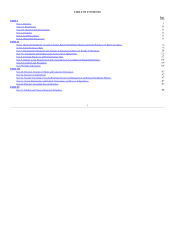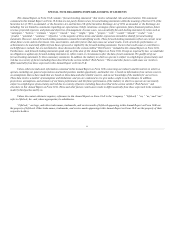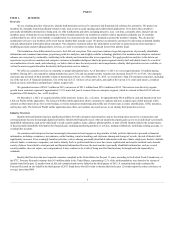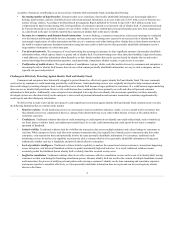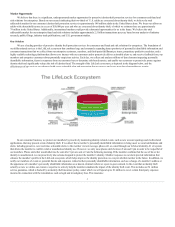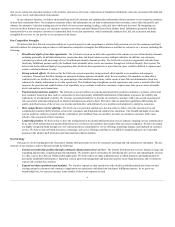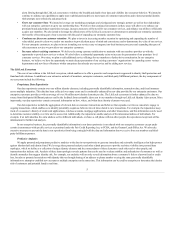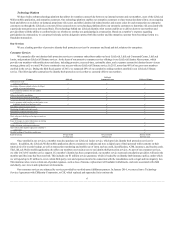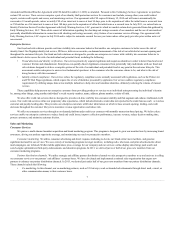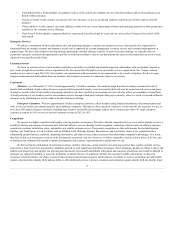LifeLock 2013 Annual Report Download - page 12
Download and view the complete annual report
Please find page 12 of the 2013 LifeLock annual report below. You can navigate through the pages in the report by either clicking on the pages listed below, or by using the keyword search tool below to find specific information within the annual report.
We protect our intellectual property rights primarily through a combination of foreign, federal, state, and common law rights, as well as contractual
restrictions. We control access to our proprietary technology by entering into confidentiality and invention assignment agreements with our employees and
contractors and confidentiality agreements with third parties.
In addition to these contractual arrangements, we also rely on a combination of patents, trademarks, service marks, domain names, copyrights, and
trade secrets to protect our intellectual property. As of December 31, 2013, we held five U.S. patents covering various systems and methods for identity based
fraud detection, and also had five U.S. patent applications pending. We pursue the registration of our trademarks, service marks, and domain names in the
United States and in certain locations abroad. Our registered trademarks in the United States include “LifeLock,” “LifeLock Identity Alert,” our logo, “ID
Analytics,” and “ID Score.”
Circumstances outside our control could pose a threat to our intellectual property rights. Effective intellectual property protection may not be available,
and the efforts we have taken to protect our proprietary rights may not be sufficient or effective. Any significant impairment of our intellectual property rights
could harm our business or our ability to compete. In addition, protecting our i ntellectual property rights is costly and time consuming. Any unauthorized
disclosure or use of our intellectual property could make it more expensive to do business and harm our operating results.
Companies in the Internet and other industries may own a large number of patents, copyrights, and trademarks and may frequently request license
agreements, threaten litigation, or file suit against us based on allegations of infringement or other violations of intellectual property rights. From time to time,
we face, and we expect to face in the future, allegations that we have infringed the trademarks, copyrights, patents, and other intellectual property rights of
third parties, including our competitors. As we face increasing competition and as our business grows, we will likely face more claims of infringement.
Our business and the information we use in our business is subject to a wide variety of federal, state, foreign, and local laws and regulations,
including the FCRA, the Gramm-Leach-Bliley Act, the FTC Act and comparable state laws that are patterned after the FTC Act, and similar laws. We also are
subject to federal and state laws and regulations relating to the channels i n which we sell and market our services. In addition, our business is subject to the
FTC Stipulated Final Judgment and Order for Permanent Injunction and Other Equitable Relief, which we refer to as the “FTC Order,” as well as the
companion orders with 35 states’ attorneys general that we entered into in March 2010. We incur significant costs to operate our business and monitor our
compliance with these laws, regulations, and consent decrees. Any changes to the existing applicable laws or regulations, or any determination that other laws
or regulations are applicable to us, could increase our costs or impede our ability to provide our services to our customers, which could have a material adverse
effect on our business, operating results, financial condition, and prospects. In addition, any of these laws or regulations is subject to revision, and we cannot
predict the impact of such changes on our business. Further, any determination that we have violated any of these laws, regulations, or consent decrees may
result in liability for fines, damages, or other penalties, which could have a material adverse effect on our business, operating results, financial condition, and
prospects.
We also are subject to federal, state, and foreign laws regarding privacy and protection of data. We post on our website our privacy policy and our
terms and conditions, which describe our practices concerning the use, transmission, and disclosure of data. Any failure by us to comply with our posted
privacy policy or privacy-related laws and regulations could result in proceedings against us by governmental authorities or others, which could harm our
business. In addition, the interpretation of data protection laws, and their application to the Internet, is unclear and in a state of flux. There is a risk that these
laws may be interpreted and applied in conflicting ways from state to state, country to country, or region to region, and in a manner that is not consistent with
our current data protection practices. Complying with these varying requirements, the evolving nature of all of these laws and regulations, the evolving nature
of various governmental bodies’ enforcement efforts, and the possibility of new laws in this area, could increase our costs or impede our ability to provide our
services to our customers, which could have a material adverse effect on our business, operating results, financial condition, and prospects. Further, any
failure by us to adequately protect our members’ privacy and data could result in a loss of member confidence in our services and ultimately in a loss of
members and enterprise customers, which could adversely affect our business.
In March 2010, we and Todd Davis, our Chairman and Chief Executive Officer, entered into the FTC Order. The FTC Order was the result of a
settlement of the allegations by the FTC that certain of our advertising and marketing practices constituted deceptive acts or practices in violation of the FTC
Act, which settlement made no admission as to the allegations related to such pra ctices. The FTC Order imposes on us and Mr. Davis certain injunctive
provisions relating to our advertising and marketing of our identity theft protection services, such as enjoining us from making any misrepresentation of “the
means, methods, procedures, effects, effectiveness, coverage, or scope of” our identity theft protection services. However, the bulk of the more specific
injunctive provisions have no direct impact on the advertising and marketing of our current services because we have made significant changes in the nature of
the services we offer to consumers since the investigation by the FTC in 2007 and 2008, including our adoption of new technology that permits us to provide
proactive protection against identity theft and identity fraud. The FTC investigation of our advertising and marketing activities occurred during the time that
we relied significantly on the receipt of fraud alerts from the credit reporting agencies for our members. The FTC believed that such alerts had inherent
limitations in terms of coverage, scope, and
9


